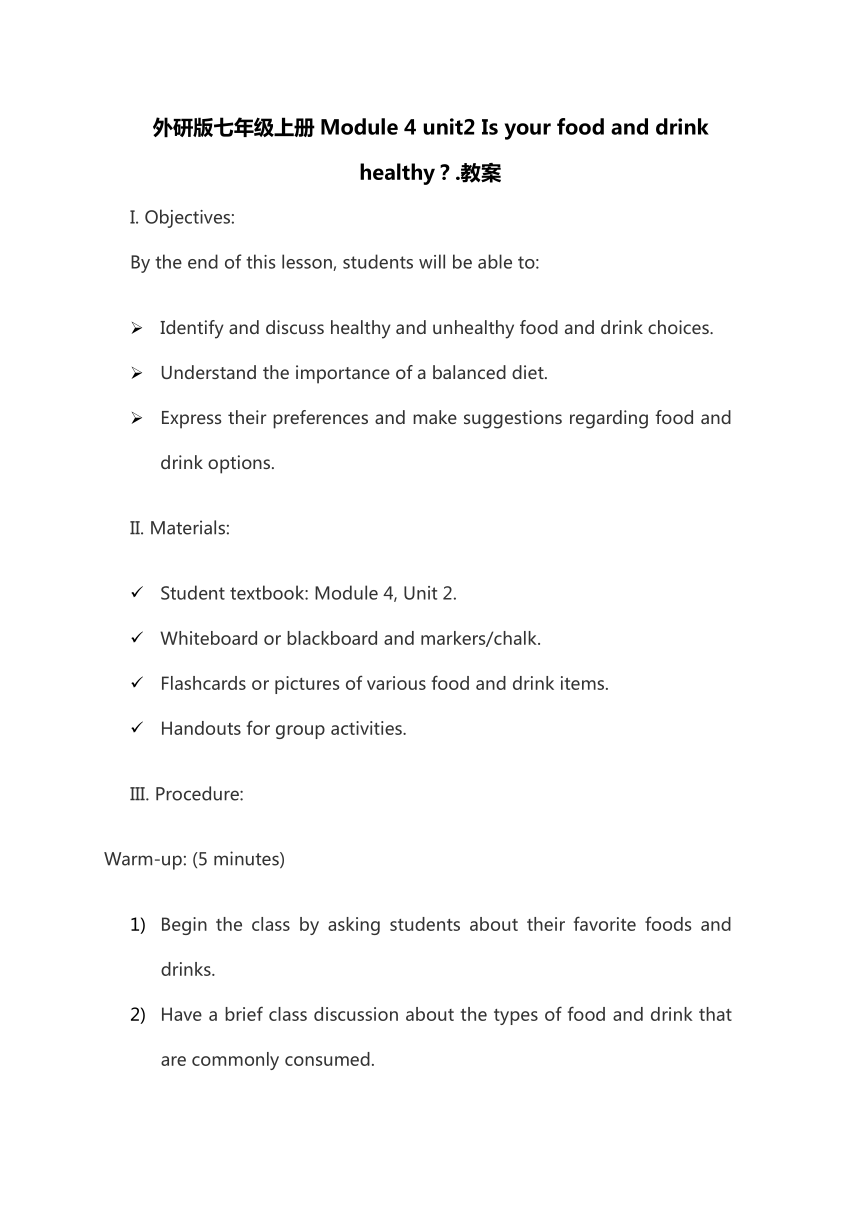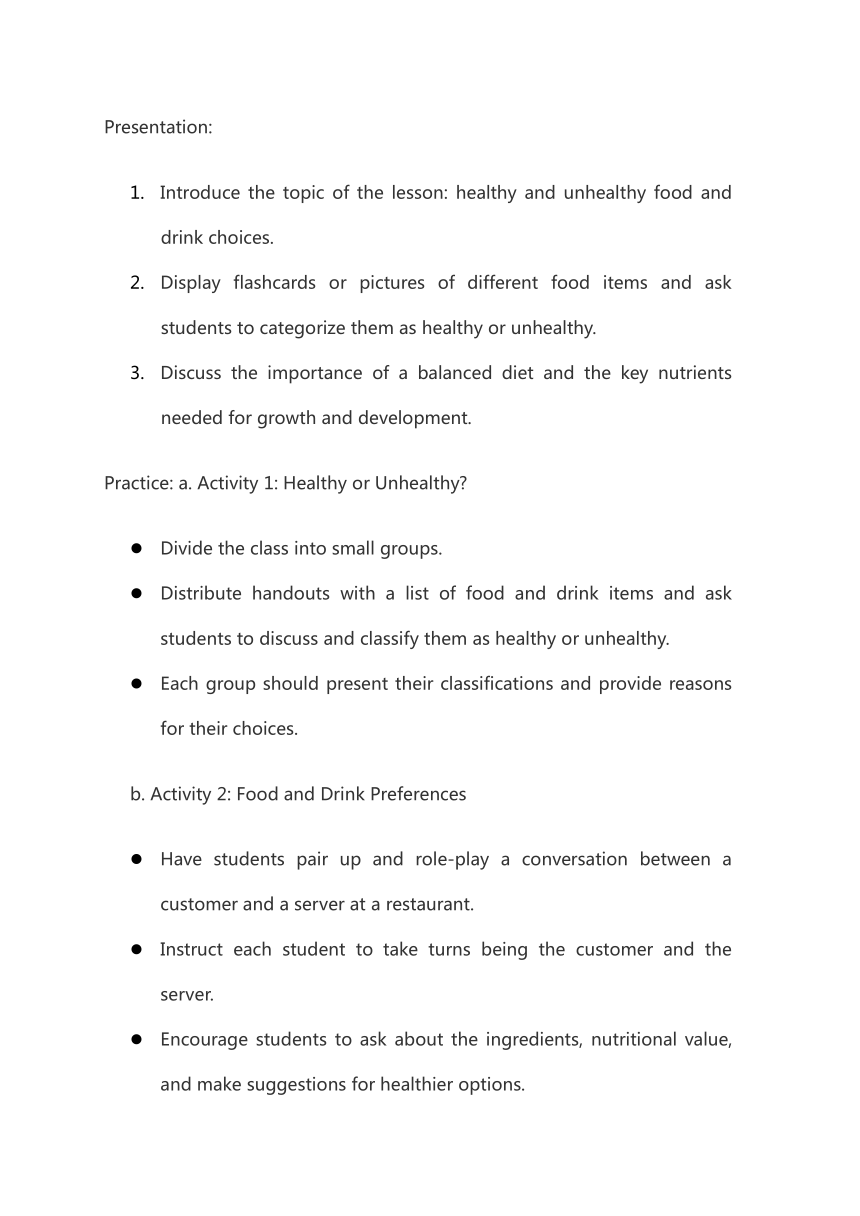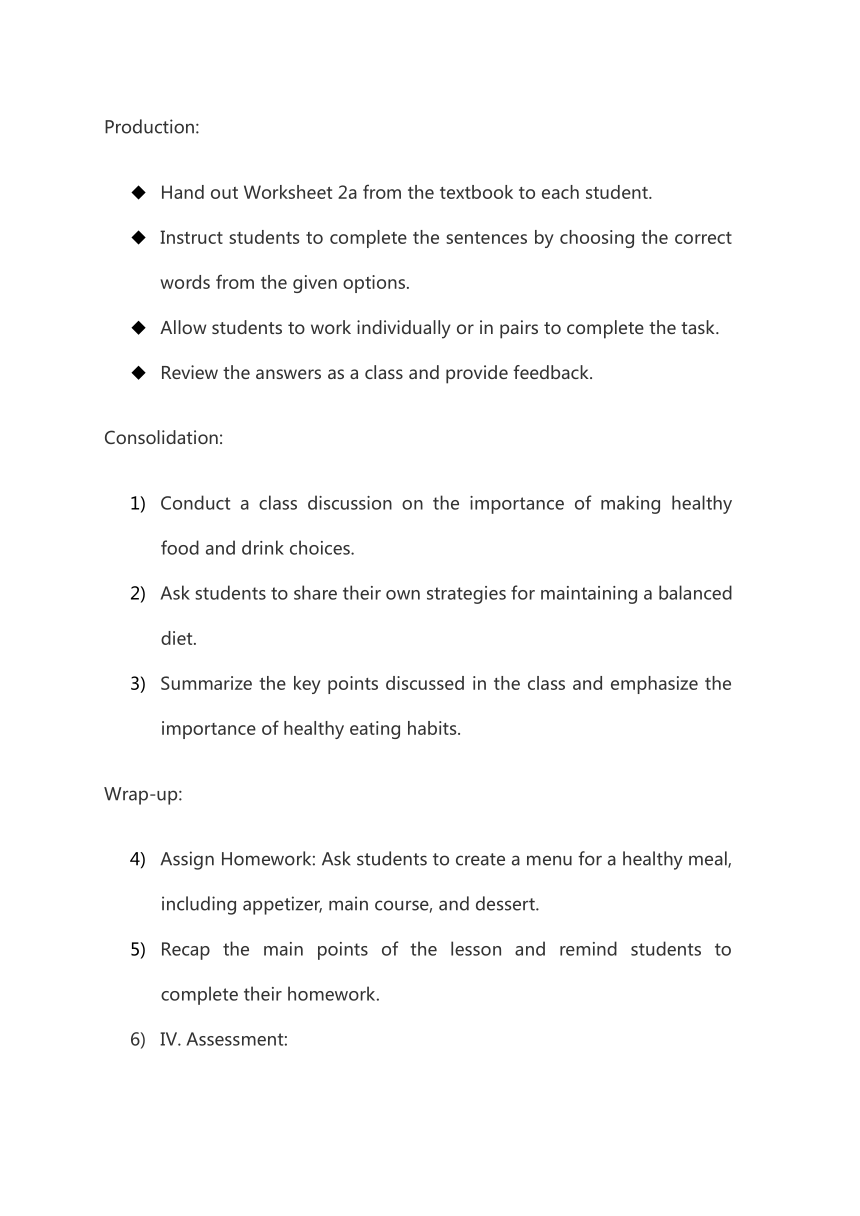外研版七年级上册Module4 unit2 Is your food and drink healthy?教案
文档属性
| 名称 | 外研版七年级上册Module4 unit2 Is your food and drink healthy?教案 |

|
|
| 格式 | docx | ||
| 文件大小 | 17.5KB | ||
| 资源类型 | 教案 | ||
| 版本资源 | 外研版 | ||
| 科目 | 英语 | ||
| 更新时间 | 2023-07-21 17:30:38 | ||
图片预览



文档简介
外研版七年级上册Module 4 unit2 Is your food and drink healthy?.教案
I. Objectives:
By the end of this lesson, students will be able to:
Identify and discuss healthy and unhealthy food and drink choices.
Understand the importance of a balanced diet.
Express their preferences and make suggestions regarding food and drink options.
II. Materials:
Student textbook: Module 4, Unit 2.
Whiteboard or blackboard and markers/chalk.
Flashcards or pictures of various food and drink items.
Handouts for group activities.
III. Procedure:
Warm-up: (5 minutes)
Begin the class by asking students about their favorite foods and drinks.
Have a brief class discussion about the types of food and drink that are commonly consumed.
Presentation:
Introduce the topic of the lesson: healthy and unhealthy food and drink choices.
Display flashcards or pictures of different food items and ask students to categorize them as healthy or unhealthy.
Discuss the importance of a balanced diet and the key nutrients needed for growth and development.
Practice: a. Activity 1: Healthy or Unhealthy
Divide the class into small groups.
Distribute handouts with a list of food and drink items and ask students to discuss and classify them as healthy or unhealthy.
Each group should present their classifications and provide reasons for their choices.
b. Activity 2: Food and Drink Preferences
Have students pair up and role-play a conversation between a customer and a server at a restaurant.
Instruct each student to take turns being the customer and the server.
Encourage students to ask about the ingredients, nutritional value, and make suggestions for healthier options.
Production:
Hand out Worksheet 2a from the textbook to each student.
Instruct students to complete the sentences by choosing the correct words from the given options.
Allow students to work individually or in pairs to complete the task.
Review the answers as a class and provide feedback.
Consolidation:
Conduct a class discussion on the importance of making healthy food and drink choices.
Ask students to share their own strategies for maintaining a balanced diet.
Summarize the key points discussed in the class and emphasize the importance of healthy eating habits.
Wrap-up:
Assign Homework: Ask students to create a menu for a healthy meal, including appetizer, main course, and dessert.
Recap the main points of the lesson and remind students to complete their homework.
IV. Assessment:
Assess students based on their participation in group activities, effectiveness of their role plays, completion of the worksheet, and the quality of their homework assignment.
Extension Activities:
Healthy Food Poster:
Divide the class into small groups.
Provide each group with a large piece of paper and art supplies.
Instruct students to create a poster promoting healthy food choices.
Encourage them to include colorful illustrations, catchy slogans, and information about the nutritional benefits of different foods.
Hang the posters around the classroom or in a common area to raise awareness about healthy eating.
Class Survey:
Have students conduct a survey among their classmates or family members to find out their favorite healthy food and drink choices.
Instruct them to create a simple questionnaire and collect responses.
Gather the data and guide a class discussion on the most popular healthy options.
Discuss the variety of choices and the importance of individual preferences when making healthy food and drink choices.
Recipe Exchange:
Divide the class into pairs or small groups.
Ask each group to research and find a healthy recipe.
Instruct students to exchange recipes with another group and discuss the ingredients and cooking methods.
Have each group present their assigned recipe to the class, including the nutritional value and benefits of the dish.
Encourage students to try out the recipes at home and share their experiences with the class.
VI. Homework:
In addition to the previous homework assignment (creating a healthy meal menu), ask students to write a short paragraph explaining why they believe it is important to maintain a balanced diet.
Encourage them to include personal experiences or observations to support their opinion.
Assessment:
Evaluate students’ participation in the extension activities.
Assess their ability to apply the knowledge gained in the lesson to practical scenarios, such as creating a poster, conducting a survey, and sharing recipes.
Review and provide feedback on their written homework assignments.
I. Objectives:
By the end of this lesson, students will be able to:
Identify and discuss healthy and unhealthy food and drink choices.
Understand the importance of a balanced diet.
Express their preferences and make suggestions regarding food and drink options.
II. Materials:
Student textbook: Module 4, Unit 2.
Whiteboard or blackboard and markers/chalk.
Flashcards or pictures of various food and drink items.
Handouts for group activities.
III. Procedure:
Warm-up: (5 minutes)
Begin the class by asking students about their favorite foods and drinks.
Have a brief class discussion about the types of food and drink that are commonly consumed.
Presentation:
Introduce the topic of the lesson: healthy and unhealthy food and drink choices.
Display flashcards or pictures of different food items and ask students to categorize them as healthy or unhealthy.
Discuss the importance of a balanced diet and the key nutrients needed for growth and development.
Practice: a. Activity 1: Healthy or Unhealthy
Divide the class into small groups.
Distribute handouts with a list of food and drink items and ask students to discuss and classify them as healthy or unhealthy.
Each group should present their classifications and provide reasons for their choices.
b. Activity 2: Food and Drink Preferences
Have students pair up and role-play a conversation between a customer and a server at a restaurant.
Instruct each student to take turns being the customer and the server.
Encourage students to ask about the ingredients, nutritional value, and make suggestions for healthier options.
Production:
Hand out Worksheet 2a from the textbook to each student.
Instruct students to complete the sentences by choosing the correct words from the given options.
Allow students to work individually or in pairs to complete the task.
Review the answers as a class and provide feedback.
Consolidation:
Conduct a class discussion on the importance of making healthy food and drink choices.
Ask students to share their own strategies for maintaining a balanced diet.
Summarize the key points discussed in the class and emphasize the importance of healthy eating habits.
Wrap-up:
Assign Homework: Ask students to create a menu for a healthy meal, including appetizer, main course, and dessert.
Recap the main points of the lesson and remind students to complete their homework.
IV. Assessment:
Assess students based on their participation in group activities, effectiveness of their role plays, completion of the worksheet, and the quality of their homework assignment.
Extension Activities:
Healthy Food Poster:
Divide the class into small groups.
Provide each group with a large piece of paper and art supplies.
Instruct students to create a poster promoting healthy food choices.
Encourage them to include colorful illustrations, catchy slogans, and information about the nutritional benefits of different foods.
Hang the posters around the classroom or in a common area to raise awareness about healthy eating.
Class Survey:
Have students conduct a survey among their classmates or family members to find out their favorite healthy food and drink choices.
Instruct them to create a simple questionnaire and collect responses.
Gather the data and guide a class discussion on the most popular healthy options.
Discuss the variety of choices and the importance of individual preferences when making healthy food and drink choices.
Recipe Exchange:
Divide the class into pairs or small groups.
Ask each group to research and find a healthy recipe.
Instruct students to exchange recipes with another group and discuss the ingredients and cooking methods.
Have each group present their assigned recipe to the class, including the nutritional value and benefits of the dish.
Encourage students to try out the recipes at home and share their experiences with the class.
VI. Homework:
In addition to the previous homework assignment (creating a healthy meal menu), ask students to write a short paragraph explaining why they believe it is important to maintain a balanced diet.
Encourage them to include personal experiences or observations to support their opinion.
Assessment:
Evaluate students’ participation in the extension activities.
Assess their ability to apply the knowledge gained in the lesson to practical scenarios, such as creating a poster, conducting a survey, and sharing recipes.
Review and provide feedback on their written homework assignments.
同课章节目录
- Starte
- Module 1 My teacher and my friends
- Module 2 My English lesson
- Module 3 My English book
- Module 4 My everyday life
- Module 1 My classmates
- Unit 1 Nice to meet you.
- Unit 2 I'm Wang Lingling and I'm thirteen years ol
- Unit 3 Language in use.
- Module 2 My family
- Unit 1 Is this your mum?
- Unit 2 These are my parents.
- Unit 3 Language in use.
- Module 3 My school
- Unit 1 There are thirty students in my class.
- Unit 2 The library is on the left of the playgroun
- Unit 3 Language in use.
- Module 4 Healthy food
- Unit 1 We've got lots of apples.
- Unit 2 Is your food and drink healthy?
- Unit 3 Language in use.
- Module 5 My school day
- Unit 1 I love history.
- Unit 2 We start work at nine o'clock.
- Unit 3 Language in use.
- Revision module A
- Module 6 A trip to the zoo
- Unit 1 Does it eat meat?
- Unit 2 The tiger lives in Asia.
- Unit 3 Language in use.
- Module 7 Computers
- Unit 1 How do I write my homework on the computer?
- Unit 2 When do you use a computer?
- Unit 3 Language in use.
- Module 8 Choosing presents
- Unit 1 I always like birthday parties.
- Unit 2 She often goes to concerts.
- Unit 3 Language in use.
- Module 9 People and places
- Unit 1 We're enjoying the school trip a lot.
- Unit 2 They're waiting for buses or trains.
- Unit 3 Language in use.
- Module 10 Spring Festival
- Unit 1 Are you getting ready for Spring Festival?
- Unit 2 My mother's cleaning our houses and sweepin
- Unit 3 Language in use.
- Revision module B
